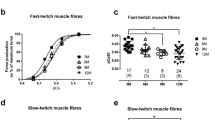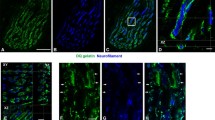Summary
The appearance of collagen around individual fast twitch (FT) and slow twitch (ST) muscle fibres was investigated in skeletal muscles with different contractile properties using endurance trained and untrained rats as experimental animals. The collagenous connective tissue was analyzed by measuring hydroxyproline biochemically and by staining collagenous material histochemically in M. soleus (MS), M. rectus femoris (MRF), and M. gastrocnemius (MG). The concentration of hydroxyproline in the ST fibres dissected from MS (2.72±0.35 Μg·mg−1 d.w.) was significantly higher than that of the FT fibres dissected from MRF (1.52±0.33 Μg·mg−1 d.w.). Similarly, the concentration of hydroxyproline was higher in ST (2.54±0.51 ⧎g·mg−1 d.w.) than in FT fibres (1.60±0.43 Μg·mg−1 d.w.), when the fibres were dissected from the same muscle, MG. Histochemical staining of collagenous material agreed with the biochemical evidence that MS and the slow twitch area of MG are more collagenous than MRF and the fast twitch area of MG both at the level of perimysium and endomysium. The variables were not affected by endurance training. When discussing the role of collagen in the function of skeletal muscle it is suggested that the different functional demands of different skeletal muscles are also reflected in the structure of intramuscular connective tissue, even at the level of endomysial collagen. It is supposed that the known differences in the elastic properties of fast tetanic muscle compared to slow tonic muscle as, e.g., the higher compliance of fast muscle could at least partly be explained in terms of the amount, type, and structure of intramuscular collagen.
Similar content being viewed by others
References
Andersen P, Kroese AJ (1978) Capillary supply in soleus and gastrocnemius muscles of man. Pfluegers Arch 375: 245–251
Armstrong RB, Saubert IV CW, Seeherman HJ, Taylor CR (1982) Distribution of fiber types in locomotory muscles of dogs. Am J Anat 163: 87–98
Bailey AJ, Sims TJ (1977) Meat tenderness: Distribution of molecular species of collagen in bovine muscle. J Sci Food Agric 28: 565–570
Borg TK, Caulfield JB (1980) Morphology of connective tissue in skeletal muscle. Tissue Cell 12: 197–207
Brodsky B, Eikenberry EF (1982) Characterizations of fibrous forms of collagen. In: Cunningham LW, Frederiksen DW (eds) Methods in enzymology, vol 82. Structural and contractile proteins. Academic Press, New York, pp 127–174
Cavagna GA (1977) Storage and utilization of elastic energy in skeletal muscle. In: Hutton RS (ed) Exercise and sport sciences reviews, vol 5. Journal Publishing Affiliates, Santa Barbara, pp 89–129
Cavanagh PR, Komi PV (1979) Electromechanical delay in human skeletal muscle under concentric and eccentric contractions. Eur J Appl Physiol 42: 159–163
Duance VC, Black CM, Dubowitz V, Hughes GRV, Bailey AJ (1980) Polymyositis — an immunofluorescence study on the distribution of collagen types. Muscle and Nerve 3: 487–490
Fietzek PP, Kühn K (1976) The primary structure of collagen. In: Hall DA, Jackson DS (eds) International review of connective tissue research, vol 7. Academic Press, London, pp 1–60
Foidart M, Foidart JM, Engel WK (1981) Collagen localization in normal and fibrotic human skeletal muscle. Arch Neurol 38: 152–157
Garcia-Bunuel L, Garcia-Bunuel VM (1967) Connective tissue and the pentose phosphate pathway in normal and denervated muscle. Nature 4: 913–914
Gay S, Balleisen L, Remberger K, Fietzek PP, Adelmann BC, Kühn K (1975) Immunohistochemical evidence for the presence of collagen type III in human arterial walls, arterial thrombi, and in leucocytes, incubated with collagen in vitro. Klin Wochenschr 53: 899–902
Gollnick PD (1982) Relationship of strength and endurance with skeletal muscle structure and metabolic potential. Int J Sports Med 3: 26–32
Gould RP (1973) The microanatomy of muscle. In: Bourne GH (ed) The structure and function of muscle, vol 2, part 2. Academic Press, New York, pp 186–243
Harkness RD (1968) Mechanical properties of collagenous tissues. In: Gould BS (ed) Treatise on collagen, vol 2. Biology of collagen, part A. Academic Press, London, pp 248–299
Herovici C (1963) A polychrome stain for differentiating precollagen from collagen. Stain Technol 38: 204–205
Hill AV (1970) First and last experiments in muscle mechanics. Cambridge University Press, London
Hudlicka O (1982) Growth of capillaries in skeletal and cardiac muscle. Circ Res 50: 451–461
Huxley AF (1974) Muscular contraction. Review lecture. J Physiol 243: 1–43
Huxley AF, Simmons RM (1971) Proposed mechanism of force generation in striated muscle. Nature 233: 533–538
Jaweed MM, Gordon EE, Herbison GJ, Kowalski K (1974) Endurance and strengthening exercise adaptations: 1. Protein changes in skeletal muscles. Arch Phys Med Rehabil 55: 513–517
Kivirikko KI, Laitinen O, Prockop DJ (1967) Modifications of a specific assay for hydroxyproline in urine. Anal Biochem 19: 249–255
Komi PV, Cavanagh PR (1977) Electromechanical delay in human skeletal muscle. Med Sci Sports 9: 49
Kovanen V, Suominen H, Heikkinen E (1980) Connective tissue of “fast” and “slow” skeletal muscle in rats — effects of endurance training. Acta Physiol Scand 108: 173–180
KovanenV, SuominenH, Heikkinen E (1982) Connective tissue of skeletal muscle — effects of age and physical training. Copenhagen, VIIIth Meeting of the Federation of European Connective Tissue Societies, abstracts, p 88
Laurent GJ, Sparrow MP, Bates PC, Millward DJ (1978) Collagen content and turnover in cardiac and skeletal muscles of the adult fowl and the changes during stretch-induced growth. Biochem J 176: 419–427
Light ND (1982) Estimation of types I and III collagens in whole tissue by quantitation of CNBr peptides on SDS-polyacrylamide gels. Biochim Biophys Acta 702: 30–36
Minari O, Zilversmit DB (1963) Use of KCN for stabilization of color in direct nesslerization of Kjeldahl digests. Anal Biochem 6: 320–327
Nowack H, Gay S, Wick G, Becker U, Timpl R (1976) Preparation and use in immunohistology of antibodies specific for type I and III collagen and procollagen. J Immunol Methods 12: 117–124
Padykula HA, Herman E (1955) The specificity of the histochemical method of adenosine triphosphatase. J Histochem Cytochem 3: 170–195
Peltonen L, MyllylÄ R, Tolonen U, MyllylÄ VV (1983) Changes in collagen metabolism in diseased muscle II. Immunohistochemical studies. Arch Neurol 39: 756–759
Plaut GWE (1969) Isocitrate dehydrogenase (DPN-specific) from bovine heart. In: Lowenstein JM (ed) Methods in enzymology, vol XIII, Citric acid cycle. Academic Press, New York, pp 34–42
Rehunen S, HÄrkönen M (1980) High-energy phosphate compounds in human slow-twitch and fast-twitch muscle fibres. Scand J Clin Lab Invest 40: 45–54
Romeis B (1968) Mikroskopische Technik. R Oldenburg Verlag, München
Saltin P, Henriksson J, Nygaard E, Andersen P (1977) Fiber types and metabolic potentials of skeletal muscles in sedentary man and endurance runners. In: Milvy P (ed) The marathon: physiological, medical, epidemiological, and psychological studies. New York Academy of Sciences, New York, pp 3–29
Stephens HR, Duance VC, Dunn MJ, Bailey AJ, Dubowitz V (1982) Collagen types in neuromuscular diseases. J Neurol Sci 53: 45–62
Suominen H, Kovanen V, Heikkinen E (1980) Biomechanical properties of “fast” and “slow” skeletal muscle in physically trained and lathyritic rats — the role of connective tissue. Prague, VIIth European symposium on connective tissue research, abstracts, p 284
Turto H, Lindy S, Halme J (1974) Protocollagen proline hydroxylase activity in work-induced hypertrophy of rat muscle. Am J Physiol 226: 63–65
Walls EW (1968) The microanatomy of muscle. In: Bourne GH (ed) The structure and function of muscle, vol 1. Structure. Academic Press, New York, pp 21–61
Viitasalo J, Komi PV (1981) Effects of fatique on isometric force- and relaxation-time characteristics in human muscle. Acta Physiol Scand 111: 87–95
Author information
Authors and Affiliations
Additional information
This study was supported by grants from the Finnish Research Council for Physical Education and Sport (Ministry of Education) and the Academy of Finnland
Rights and permissions
About this article
Cite this article
Kovanen, V., Suominen, H. & Heikkinen, E. Collagen of slow twitch and fast twitch muscle fibres in different types of rat skeletal muscle. Europ. J. Appl. Physiol. 52, 235–242 (1984). https://doi.org/10.1007/BF00433399
Accepted:
Issue Date:
DOI: https://doi.org/10.1007/BF00433399




